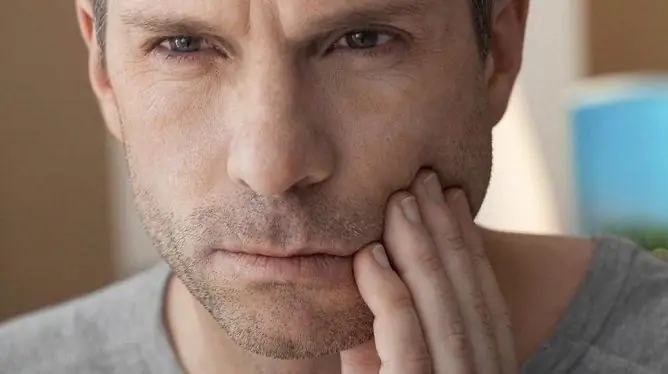- Author Rachel Wainwright [email protected].
- Public 2023-12-15 07:39.
- Last modified 2025-11-02 20:14.
Swelling of the eyelids
Swelling of the eyelids is a symptom of various diseases, and can also develop against the background of inflammatory processes on the face (sinusitis, inflammation of the paranasal sinuses, conjunctivitis, acne, etc.).
Causes and features of eyelid edema

Swelling of the eyelids can be both in one eye and in the upper eyelids of both eyes, and can also be local in nature (on the upper or lower eyelid), and spread throughout the entire area around the eyes. Lower eyelid edema is mainly associated with a reaction to blepharitis, barley, meibomitis, etc.
Swelling of the eyelids in a child is often provoked by various inflammatory processes and allergic reactions. Symptoms of this disorder are painful sensations in the eyelids, severe skin hyperemia and increased body temperature. An eyelid with swelling when palpated may have a subcutaneous lump with inflamed fluid.
The causes of non-inflammatory swelling of the eyelids are diseases of the heart and kidneys. Basically, this swelling occurs in the morning and is combined with swelling of the legs.
Common causes of eyelid edema can be allergic reactions, including angioedema and reactions to various allergens, such as food, flowers and plants, cosmetics and medicines.
Swelling of the eyelids in a child can be caused by specific irritants, including animal hair, plant pollen and tissues.
The most likely causes of upper eyelid edema are:
- inflammatory and infectious processes;
- trauma;
- eye diseases and damage;
- diseases of the internal organs;
- allergic reactions;
- improper lifestyle (systematic overwork and lack of sleep, stress, bad habits, excessive consumption of liquids and salty foods).
Congenital structural features of the eyelids are the most rare cause of edema.
Usually this condition is associated with a thin membrane that is located between the subcutaneous tissue. Over time, the membrane can become thinner and any factor can provoke swelling of the upper eyelids.
Types of edema of the upper eyelids
Currently, several types of eyelid edema are distinguished in medicine. These include:
- inflammatory edema caused by furunculosis, barley, dacryocystitis, conjunctivitis and colds;
- non-inflammatory edema associated with diseases of internal organs (heart, liver, kidneys and lungs);
- allergic edema of the upper eyelids, which occur along with other reactions to the allergen;
- traumatic edema, which can occur from blows and hemorrhages under the skin, as well as from insect bites.
Treatment of eyelid edema
The main treatment for eyelid edema is to address the underlying cause of the inflammation.

In the case when the edema is of an allergic nature, it is necessary to take antihistamines, antiallergic ointments and drops (Opatanol, Lekrolin, Loratadin, etc.), as well as hormonal drugs.
If swelling of the eyelids occurs after insect bites, you can limit yourself to the use of anti-inflammatory and decongestant ointments. If the swelling of the eyelids continues for a long time or manifests itself in the form of a severe inflammatory process, then you should immediately contact your doctor for special treatment.
For the treatment of edema of the upper eyelids, decongestants, soothing and antibacterial drops are prescribed, which constrict the blood vessels. As additional means of treatment, you can use cold lotions and compresses with an infusion of medicinal herbs, as well as a solution of novocaine.
If the swelling of the eyelids is caused by the effects of cosmetics or is a consequence of anatomical features, then lymph drainage massage, electrical stimulation and mesotherapy are prescribed. These procedures are aimed at normalizing cell metabolism and improving blood circulation.
YouTube video related to the article:
The information is generalized and provided for informational purposes only. At the first sign of illness, see your doctor. Self-medication is hazardous to health!






